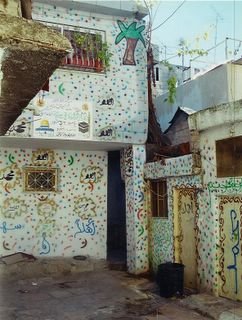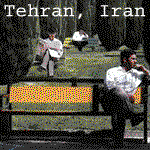THE BLACK POPULATION OF ISRAEL

One of their Homes

More Photo's
---------THE BLACKS OF EIN-DUKE AND NUWAYMA--------JERICHO
More than 10,000 blacks of Nubian heritage live in dire poverty on the outskirts of Jericho. On the old Tiberius Road, just north of the ancient ruins of Jericho, the sandy slopes of the Judean mountains serve as a backdrop for the villages of Nuwayma to the right and Ein-Duke (spring rooster) to the left. Some of the families have made their homes in the abandoned mud and straw hovels left over from the 1948 Palestinian refugee camps. According to residents of Nuwayma, many of the blacks once lived in the Judean caves and later under burlap tents as the desert bedouins have done for centuries. In 1980, electricity was finally introduced to the villages. In 1985, only one home in the entire community had a television. During the summer months, as night-fall approaches, the children herd the animals inside to keep them from wandering off, while the family sleeps outdoors on raised platforms built of wood, petroleum barrels and colorful hand-made quilts.
The blacks of Jericho make their living by working the fields in the Jordan Valley. They earn an average of $50 for working a 72-hour week. Should they need food to feed their families, the landowners will permit them to take food from the fields with the understanding the difference will be deducted from their meager wages. Those families fortunate enough to rent land owe as much as half of their crop to the owners at harvest time. The children of these communities attend school in the United Nations Relief Associate (UNRA) system. They usually complete two years of high school and most of them return to the fields to work along side their parents.
----------WHERE DID THEY COME FROM?---------------
It is important to note that documented information concerning these Nubian descendants is limited. The Beir Zeit University, Bethlehem University and the schools of study within Israel have no research that relates to this group.
During the 1,000 year existence of Nubia (that area of northeast Africa west of the Red Sea which formerly encompassed Egypt and the Sudan) several battles were fought between the Nubian Kingdom and the Assyrian Empire in and around the area known as historical Palestine. It was customary during this time to take as part of the spoil, slaves from the conquered country. Some historians believe a few of the Nubian slaves managed to escape from their captors and settled in the Jordan Valley.
Doctor Charles Copher of the Interdenominational Theological Center in Atlanta believes the origin of these black people dates back further than any of the popular opinions. Dr. Copher and other noted biblical historians believe they are descendants of the original inhabitants of the Jordan Valley. The small community of Sudanese who have lived in the Old City of Jerusalem for centuries are believed to be of the same lineage.
--------------THE YEMENITES----------
The Yemenites (known as the Black Jews) came to Israel shortly after the state was given national status. The dramatic rescue mission of nearly 50,000 oppressed Yemenite Jews was known as "Operation Magic Carpet." They are culturally rich and live mostly within their own communities, the largest being Maimric and Sha'arim in Rehovot, which is about 10 kilometers southeast of Tel Aviv. Many Yemenites also reside in Petach Tequa which is just outside of Tel Aviv.
Nearly all of the Yemenites once lived in and around Tiberias (the Kenneret) on the Sea of Galilee until they became pawns for various political factions shortly after their arrival. In 1950, the United Religious Front, which originally was responsible to place the Yemenite children in the educational system, boycotted the government cabinet meetings. The Ministry of Education then assumed the responsibility of sorting out the children in the absorption centers and deciding which schools they would attend. The Yemenite children were automatically placed in the Mizrahi schools, which was religious-Zionist in its orientation - similar to today's Gush-Emunim. The parents of the Yemenite children could not comprehend the government's actions, which would later lead to the erosion of their families. The teachings in the Mizrahi schools would later encourage impressionable children to challenge the teachings and customs of their parents. Thomas Herzl, the father of Zionism, and Ben-Gurion never intended for Israel to become a religious state. The Yemenites, like most oriental Jews, expressed a clear definition of their religion which permeated every area of their lives. The Israeli government was determined to form a social democracy and saw the strict and intolerable religious rules of the Yemenites as a threat. Within months after "Operation Magic Carpet" the government placed the Yemenites on the kibbutzim and moshavim that were almost uninhabitable and isolated simply because the Iraelis wished to ignore the Yemenites religious extremism.
One substance that is unique to the Yemenites is a leafy
matter called Qat (ironically pronounced "pot"). It's chewed by the Yemenites especially if they need to stay awake for long hours. Yemenite men still smoke the nagila individually or in communal settings.
----------THE ETHIOPIAN JEWS-----------
About 25,000 Ethiopian Jews came to Israel in January 1985 in "Operation Moses." The Israeli authorities tried to encourage the new arrivals to pursue trades where they already showed expertise. To their surprise, the Ethiopian Jews wanted no part of working the land. Many of them had never seen an automobile or television. Some selected more challenging careers (automechanics, engineering, computer technology) while others went to school.
The tragedy of "Operation Moses," was the unwillingness of the Orthodox Jewish community to accept the Ethiopians as Jews after they had been waiting for thousands of years to come to the promised land. Aside from the chief rabbi questioning the authenticity of their Judaism, the drastic cultural and technological changes led some to commit suicide, some returned to Ethiopia, a few moved to other countries, and some resorted to crime. Many of the women who were pregnant wanted to return to Ethiopia to give birth for fear if they stayed in Israel their babies would not be born black. For the most part, although the adjustment has been long and trying, most have remained and are faring relatively well.
---------------THE BLACK HEBREWS OF DEMONA AND ARATS-----------
It is not necessary to retrace all the steps that led Ben Ami-Carter and his followers to claim themselves as heirs to the land of historical Israel. The popular media has exhausted that topic since their arrival in Demona. It would be grossly unfair not to examine their resilience for the past 15 years. They started coming to Israel from the United States in the mid 70's and upon their arrival, they destroyed their documents of identification. After nearly two decades, they still haven't been granted a status by the Israeli government. The United States is steadfast in its' decision not to allow them to return there. Today the commune and the Israeli authorities remain embroiled in the conflict that deals with their lack of status and documentation. They have managed to survive by opening several vegetarian restaurants. The Black Hebrews have also organized a gospel group, and jazz and reggae bands that tour the country, bringing in additional revenue. There is also a garment and jewelry factory located within the commune.
The Sudanese community in the "Old City", which has been in residence for several hundred years. The Druze live mostly in the Carmel and Haifa region of the country. These Black Arab druzes enjoy the privileges of full Israeli citizenship. They are notorious for their hard-line approach to dealing with other Arabs, especially during the intifada, the Arab term for uprising.














0 Comments:
Post a Comment
<< Home